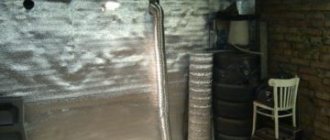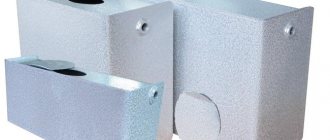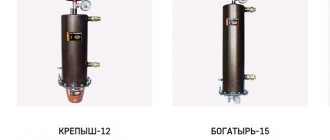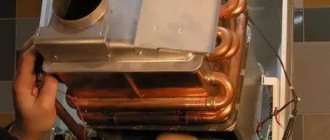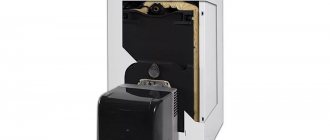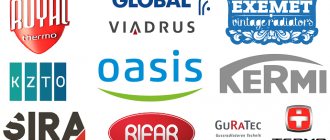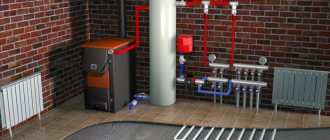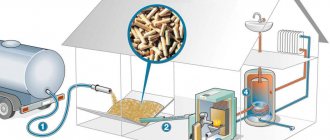Heating equipment mounted on walls and ceilings, including portable heating devices, to a certain extent is an integral part of the interior, requiring decoration and occupying some volume in the room.
With the development of technologies for the production of heating equipment, units have appeared on the heater market that do not reduce the usable volume of the premises - heating convectors built flush into the floor.
Group sequential arrangement under a common grille of convector-type heaters installed in the floor along the perimeter of a circular arrangement of panoramic window openings
In-floor heating convectors are widely in demand in spacious administrative and residential premises with glass enclosing structures, as well as public transit structures (corridors, passages, waiting rooms), where they, without being conspicuous, effectively fulfill their purpose - maintaining the required temperature regime.
In-floor convector heater mounted along the observation external glazing of the room.
General understanding of floor-mounted convectors
Convectors that are simply built into the floor are a durable rectangular body, often framed, covered on the front side with a decorative metal grille. The housing contains a heat exchanger that is heated, depending on the type of heating device, by the coolant or electric heater circulating through it.
*
In-floor heating convectors are installed in separate point or general linear niches made in the load-bearing floor according to the size of the heaters, as well as in the space between the raised floor and the concrete base. To reduce heat loss, the bottom and side walls of the casing of in-floor convectors are equipped with external thermal insulation.
The design of such heaters includes adjustment screws that allow precise adjustment of the horizontal position of the front grille plane to the level of the finished floor covering, so that the protruding parts of the body do not create obstacles when walking on them.
Sectional diagram of the device in the floor of an in-floor convector
For more efficient use, floor-mounted heaters are located along panoramic glass enclosing structures and window openings in order to use convective flows also as a thermal curtain between the room space and the cold glazing surface.
Option for installing a TURBO VKN5 duct convector with a fan into the floor.
Recommendations for selection and installation
When selecting built-in heating, two factors are important: available thermal power and compliance with the interior of the room. Manufacturers must indicate the power value in the technical data sheet for the product, so it is not difficult to make a choice in this regard. You just need to know the need for thermal energy for each heated room.
Attention! The thermal power of the device, declared in the manufacturer's passport, corresponds to a certain calculated coolant temperature, which in your case may be lower. You should pay special attention to this when purchasing and select a product with a certain amount of heat transfer.
It is also not difficult to choose a built-in convector based on its appearance.
The color ranges of the grilles offered are very rich, but even if you were unable to find the required color, you probably have the opportunity to order it. The size of the product in plan and its height also play a role; the latter must correspond to the thickness of the screed or raised floor. Installation of an in-floor device involves attaching it to the subfloor and aligning the surface of the product horizontally using a building level. Height adjustment is carried out by mounting brackets and is fixed. Then the connection is made to supply pipelines laid, like heated floors, from central heating or an individual boiler room. After the connection and installation of the in-floor convectors is completed, you can pour the screed.
Advice. While the laid mortar is hardening, it is necessary to put the decorative grille in its place, otherwise the screed may compress the walls of the body and then it will be difficult to insert it. The installation process is clearly shown in the video.
Types of in-floor heaters
*
There are many models of in-floor heaters produced today, and they all differ in some way from each other. If we do not consider parameters of secondary importance, then all heating convectors built into the thickness of the floor can be divided into two groups:
- water;
- electric.
The units within each of these two groups differ in size, configuration, power, design of the external grille, type of convection - natural or forced (with fan) and performance class.
Water heaters for internal floor placement
An underfloor water convector is a heating device connected to a central or autonomous heating system.
The operating diagram of a water in-floor convector is the flow of cold air from the glazing of the window opening to the heating device, its heating and exit into the room.
A valve is installed at the point of insertion into the system, which can be used to regulate the amount of coolant circulating through the floor water heater.
The main element of the unit is a radiator with inlet and outlet fittings, through which flexible hoses or fittings are used to connect to the heating system, and hot water circulates through the heat exchanger.
Connecting the radiator of a floor-mounted heater using flexible hoses.
The radiator is made of a copper pipe, on which aluminum fins are made to increase the heat transfer area. Modern water heating convectors are equipped with automatic release valves for air entering the system along with water, which eliminates the formation of air locks and ensures efficient operation of the unit due to the stable intensity of coolant circulation.
Installation of a water convector in a niche and its rigid connection to heat-insulated pipes in grooved channels.
*
The intensity of the coolant supply to the convector can be manually changed by a valve at the point of connection to the heating system, but it is more effective to install a mechanical thermostat at the inlet of the heater that regulates the flow of hot water into the heat exchanger depending on the temperature of the water in the radiator.
On the left is a schematic cross-section of a manual valve and a mechanical thermostat, on the right is a natural image of the thermostatic head.
Floor-mounted heaters with a natural type of convection are designed for heating medium-sized rooms (16-25 sq. m.).
To ensure the natural movement of convective flows, the depth of the housing box must be at least 20 cm, and yet even multi-pipe devices of the natural type of convection do not always cope with the role of the main and only means of heating, forcing homeowners to additionally use other heating devices.
Multi-pipe radiator for a floor-mounted water convector with increased heat transfer.
The main advantage of this group of in-floor heaters is safety due to the absence of factors associated with the use of electrical appliances. In-floor water heating convectors do not require grounding, are not afraid of direct contact with moisture (this often happens on the floor), the surface temperature of these units is safe for humans upon short-term touch, and the outer grille can be made of valuable wood.
Methods of arrangement of floor-mounted heaters: on the left - corner placement, on the right - installation in steps.
The cost of such devices, depending on the power, class of technical equipment and design, ranges from 20 to 100 thousand rubles.
Important! When connected to a central heating system, water heating convectors built into the floor are heaters that do not require energy costs (with the exception of models with a fan).
Forced convection type water heating devices
*
Equipping the device with a fan accelerates convective flows, but at the same time reduces their temperature - the air heats up less due to the shorter duration of contact with the heat exchanger. Therefore, the radiators of in-floor heaters with forced convection are made of a more complex design (two-three-four-pipe), up to 3 meters long, which prolongs the contact of air with the heat exchanger and increases its temperature at the outlet of the unit.
Conventional diagram of the movement of convective flows in an in-floor convector with a fan.
A floor-mounted forced-convection heater is many times more efficient than models without a fan, so they are used in large areas, and the energy consumption of such devices is low due to the lack of electric heating elements. However, the complexity of the design of tangential type fans most often used in modern heating units (with a reduced noise level, operating at a voltage of 12 V) or the equipment of the heater with several ventilation mechanisms of a traditional, diametrical type design significantly increases the cost of the convector, which can range from 50 to 160 thousand roubles.
Types of fan equipment for trench convectors: on the left - single, on the right - block, below - tangential fan.
The thermal power of a water heater is determined by the dimensions of the unit, the temperature of the supplied coolant and the type of convection, but the required calorific value (Qt) is determined by a special formula:
Formula for calculating the required power of a convector with a breakdown of the constituent elements.
However, the required heat release power also depends on other factors - region, room dimensions, glazing area, degree of thermal protection of enclosing structures, etc., therefore, its value is often determined using special tables that take into account certain operating conditions.
Electric underfloor heating units
*
These units differ from water in-floor convectors in the way they heat the heat exchanger and, naturally, in their design.
The heat exchanger is a heating element placed in a finned housing. Thus, electric floor-mounted heaters are to some extent infrared heaters, the main operating principle of which is based on convection.
Schematic diagram of an electric in-floor heater of natural convection type.
The presence of an electric heating element in the unit allows it to be connected to an automatic heating control system in order to minimize human participation in the operation of the heating device. To do this, an external mechanical thermostat is installed in the power supply circuit of the unit, which turns off the device when the room temperature reaches the set value.
Important! Automatic temperature control is effective only when installing units with a forced convection type, since the fan ensures uniform air temperature in the room and allows the temperature sensor to record its real value.
Option for wired connection of a thermostat to a floor-mounted electric heater.
All models of electric in-floor appliances are equipped with an internal temperature sensor that protects the heater from overheating.
Important! When marking the installation of electric heaters, the distance from the unit to the glazing plane should be no more than 300 mm - if this value is exceeded, nothing will prevent the formation of condensation on the glass, which, flowing onto the floor, can accumulate in the niche where the heater is located.
The height of the ceilings of most apartments does not allow painlessly pouring a layer of concrete onto the floor, allowing the in-floor heater to be recessed. It is also unrealistic to ditch the floor in the interfloor ceiling to such a depth. Therefore, you will not find an electric heater built into the floor, much less a water heater, in an apartment building. But floor convectors that are similar in design are produced and do not require installation of mounting niches in the floor for installation.
Such heating devices, both electric and water, can effectively heat spacious rooms in apartments and domestic premises for industrial purposes.
Important! The use of electric in-floor convectors is associated with sensitive energy costs, but there is a way out of this situation - the use of a 24 V DC network, which will not only reduce costs, but also increase the safety of operation of the heating unit.
Schematic connection of an in-floor convector to a 24 V network and a thermostat
Fan coil units
Based on floor-mounted convectors, another type of heater is produced that works not only for heating, but also for cooling. Depending on the installation location, in addition to the internal one, they are also wall, floor and ceiling. The Russian-language name for such a unit is fan coil - from the English fan-coil, which means fan-heat exchanger.
This definition means a combination of two devices working in pairs:
- fan coil itself - a floor-mounted mechanism for influencing air temperature, including one or more heat exchangers;
- chiller - a separately installed unit for cooling the coolant (water) supplied to the fan coil in the summer.
Fan coils are single-circuit (two-pipe) and double-circuit (four-pipe).
In single-circuit units, hot water from the central heating system or antifreeze from the heating boiler is passed through a heat exchanger in winter. In the summer, cold water from a chiller passes through the same heat exchanger - a device that does not use freon or other gas with identical characteristics for cooling.
In double-circuit fan coils, the movement of hot and cold coolants is carried out through separate heat exchangers.
Schematic representation of a double-circuit fan coil unit (without a chiller).
Thus, depending on the set mode, the fan drives room air through a hot or cold heat exchanger.
There is no universal scheme for installing a chiller-fan coil system pair; its installation is possible in any room, but the installation project will be tied to specific conditions.
One chiller, correctly selected in terms of power, can be connected to a system of many fan coil units (wall-mounted, ceiling-mounted, in-floor), serving several rooms and even buildings.
This system for ensuring the required temperature in rooms is used mainly in public and industrial buildings, as it is difficult to maintain and expensive.
How to choose an in-floor water convector
Having assessed and analyzed all the advantages and disadvantages, you need to competently approach the choice of a convector manufacturer. Prices for in-floor convectors are high, but saving on such devices can lead to serious consequences.
There are many manufacturers on the market, but the most proven, producing high-quality products are “VARMANN” (Russia), “PRIMOCLIMA” (Russia), “KZTO Radiator” (Russia), “EVA” (Russia, Sweden), “MINIB” ( Czech Republic), "MOHLENHOFF" (Germany), "SIEMENS" (Germany).
In addition to price and manufacturer, your choice should be based on the required power of the device. With a simplified approach, the standard heating power in a private house is taken to be 1000 W per 10 sq.m. room area. In stores and construction supermarkets you can find many models with power ranging from kilowatts and small dimensions to large devices of several kilowatts.
It is necessary to take into account the fact that, due to design features, “adding power” by adding elements (sections, as in a radiator) will not work. If the glazing of the house is significant or the ceiling height is more than 3 meters, you should not resort to a simplified scheme; you must entrust this important task to professionals.
Advantages and disadvantages of floor-mounted convectors
We list the positive and negative features of in-floor heaters without dividing them by the type of energy carrier used and listing the characteristics inherent in all convectors as a whole.
Pros:
- due to the location of the unit, the lower, coldest layers of air are heated;
- installation of devices does not reduce the usable volume of the room;
- quick access to working mode;
- preventing the formation of condensation on glazing.
Minuses:
- with high ceilings, building natural convection units into the floor is not effective - convective flows of heated air are concentrated high under the ceiling and cool down before they fill the actual volume of the room;
- convection from the level of the floor covering initiates intense movement of dust in the air, which is constantly present in the air during heater operation;
- inconvenience of daily care of niches in which household waste accumulates.
Application
Convection heaters are designed for heating residential and non-residential buildings where traditional heating devices are not enough, where there are large heat losses - they are built in rooms with a large area of cold walls, with glass facades, with panoramic and stained glass windows, terraces, in front of entrance doors, in hallways , vestibules, staircases.
Models of built-in convectors are installed in:
- apartments and private houses;
- offices, hotels;
- winter gardens and greenhouses;
- shopping and entertainment complexes;
- train stations, airports;
- sports clubs, swimming pools, spa salons.
Additional heating
Specialists can also talk about additional heating. What is meant? -warm floors, warm walls, someone leaves some of the heating devices and wants to install a convector only to prevent fogging of the continuous glazing. Maybe the windows overlook a loggia or balcony, this also needs to be indicated.
If you decide to combine, for example, leave one battery or install a water or electric heated floor, then you need a less powerful convector, which will allow you to save on its cost and the complexity of laying communications.
Equipment care
Floor gratings should be cleaned regularly with a damp cloth soaked in water and neutral detergents. The interior surface must be periodically cleaned with a vacuum cleaner, the frequency depends on the degree of dirtiness of the room.
If the device is used in very dirty rooms, the heat exchanger and housing must be purged with steam. To prevent the formation of mold and mildew in the pipelines, you need to make sure that the condensate collection pan is clean. Study the vertical heating battery at the link.

